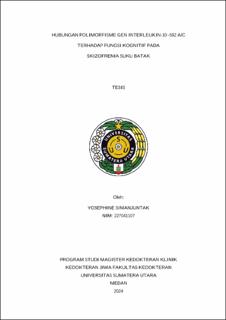| dc.description.abstract | Background: IL-10 −592A/C polymorphism has been reported to be associated with an increased risk of schizophrenia. Its neuroprotective effects on dopaminergic neurons are likely due to microglia- or macrophage-mediated release of inflammatory mediators because they can inhibit cytokine production. This is thought to influence cognitive impairment in schizophrenia through its neuroprotective action on dopaminergic neurons. However, there are still few researches studying the relationship of IL-10 −592A/C polymorphism to cognitive function in individuals with schizophrenia.
Methods: This study recruited 100 Bataknese patients with schizophrenia at Prof. Dr. M. Ildrem Mental Hospital, Medan, North Sumatera, Indonesia, who have been administered antipsychotic medications for at least two years. In addition, the IL-10 -592A/C polymorphism was analyzed using RFLP and PCR methods, while the cognitive functions were conducted by performing the MoCA-Ina (Montreal Cognitive Assessment - Indonesian version), which concern to attentions and concentrations, executive function, memory, languages, visuospatial abilities, numerical calculation, and orientation.
Results: From the results of the bivariate test using the Kruskal-Wallis test, the p-value was 0.198 (p>0.005), which means that there is no significant relationship between alleles and genotypes on the MoCA-Ina Score in the Bataknese schizophrenia patient.
Conclusion: No association was found between IL3-RA rs6603272 G/T polymorphism and Negative Symptom. No Association between Polymorphism and Negative Symptom in Bataknese Schizophrenia patient. | en_US |


